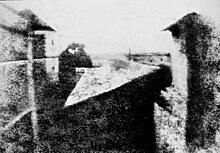Precursor technologies
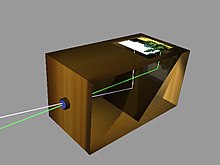
A camera obscura used for drawing images
Photography is the result of combining several technical discoveries.
Long before the first photographs were made, Chinese philosopher
Mo Di and Greek mathematicians
Aristotle and
Euclid described a
pinhole camera in the 5th and 4th centuries BCE.
[7][8] In the 6th century CE, Byzantine mathematician
Anthemius of Tralles used a type of
camera obscura in his experiments,
[9] Ibn al-Haytham (Alhazen) (965–1040) studied the camera obscura and pinhole camera,
[8][10] Albertus Magnus (1193–1280) discovered
silver nitrate,
[11] and
Georg Fabricius (1516–71) discovered
silver chloride.
[12] Techniques described in the
Book of Optics are capable of producing primitive photographs using medieval materials.
[13][14][15]
Daniele Barbaro described a
diaphragm in 1566.
[16] Wilhelm Homberg described how light darkened some chemicals (photochemical effect) in 1694.
[17] The fiction book
Giphantie, published in 1760, by French author
Tiphaigne de la Roche, described what can be interpreted as photography.
[16]
The discovery of the camera obscura that provides an image of a scene dates back to ancient China.
Leonardo da Vinci
mentions natural camerae obscurae that are formed by dark caves on the
edge of a sunlit valley. A hole in the cave wall will act as a pinhole
camera and project a laterally reversed, upside down image on a piece of
paper. So the birth of photography was primarily concerned with
inventing means to fix and retain the image produced by the camera
obscura.
Renaissance painters used the camera obscura which, in fact, gives
the optical rendering in color that dominates Western Art. The camera
obscura literally means "dark chamber" in
Latin. It is a box with a hole in it which allows light to go through and create an image onto the piece of paper.
Invention of photography
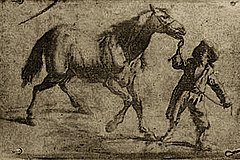
Earliest known surviving heliographic engraving, 1825, printed from a metal plate made by
Nicéphore Niépce.
[18]
The plate was exposed under an ordinary engraving and copied it by
photographic means. This was a step towards the first permanent
photograph taken with a camera.
Around the year 1800,
Thomas Wedgwood
made the first known attempt to capture the image in a camera obscura
by means of a light-sensitive substance. He used paper or white leather
treated with
silver nitrate.
Although he succeeded in capturing the shadows of objects placed on the
surface in direct sunlight, and even made shadow-copies of paintings on
glass, it was reported in 1802 that "the images formed by means of a
camera obscura have been found too faint to produce, in any moderate
time, an effect upon the nitrate of silver." The shadow images
eventually darkened all over.
[19]
The first permanent
photoetching was an image produced in 1822 by the
French inventor
Nicéphore Niépce, but it was destroyed in a later attempt to make prints from it.
[18] Niépce was successful again in 1825. In 1826 or 1827, he made the
View from the Window at Le Gras, the earliest surviving photograph from nature (i.e., of the image of a real-world scene, as formed in a
camera obscura by a
lens).
[20]
Because Niépce's camera photographs required an extremely long
exposure (at least eight hours and probably several days), he sought to greatly improve his
bitumen process or replace it with one that was more practical. In partnership with
Louis Daguerre,
he worked out post-exposure processing methods that produced visually
superior results and replaced the bitumen with a more light-sensitive
resin, but hours of exposure in the camera were still required. With an
eye to eventual commercial exploitation, the partners opted for total
secrecy.
Niépce died in 1833 and Daguerre then redirected the experiments toward the light-sensitive
silver halides,
which Niépce had abandoned many years earlier because of his inability
to make the images he captured with them light-fast and permanent.
Daguerre's efforts culminated in what would later be named the
daguerreotype process. The essential elements- a silver-plated surface sensitized by
iodine vapor, developed by
mercury vapor, and "fixed" with
sodium hyposulfite-
were in place in 1837. The required exposure time was measured in
minutes instead of hours. Daguerre took the earliest confirmed
photograph of a person in 1838 while capturing a view of a Paris street:
unlike the other pedestrian and horse-drawn traffic on the busy
boulevard, which appears deserted, one man having his boots polished
stood sufficiently still throughout the approximately ten-minute-long
exposure to be visible. The existence of Daguerre's process was publicly
announced, without details, on 7 January 1839. The news created an
international sensation. France soon agreed to pay Daguerre a pension in
exchange for the right to present his invention to the world as the
gift of France, which occurred when complete working instructions were
unveiled on 19 August 1839.
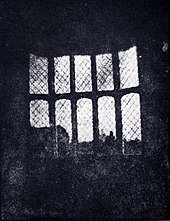
A latticed window in
Lacock Abbey, England, photographed by
William Fox Talbot in 1835. Shown here in positive form, this may be the oldest extant photographic negative made in a camera.
Meanwhile, in Brazil,
Hercules Florence had apparently started working out a silver-salt-based paper process in 1832, later naming it
Photographie, and an English inventor,
William Fox Talbot,
succeeded in making crude but reasonably light-fast silver images on
paper as early as 1834 but had kept his work secret. After reading about
Daguerre's invention in January 1839, Talbot published his method and
set about improving on it. At first, like other pre-daguerreotype
processes, Talbot's paper-based photography typically required
hours-long exposures in the camera, but in 1840 he created the
calotype
process, with exposures to a freshly-sensitized damp paper comparable
to the daguerreotype. In both its original and calotype forms, Talbot's
process, unlike Daguerre's, created a translucent
negative
which could be used to print multiple positive copies, the basis of
most chemical photography up to the present day. Daguerreotypes could
only be replicated by rephotographing them with a camera.
[21] Talbot's famous tiny paper negative of the Oriel window in
Lacock Abbey, one of a number of camera photographs he made in the summer of 1835, may be the oldest camera negative in existence.
[22][23]
John Herschel made many contributions to the new field. He invented the
cyanotype
process, later familiar as the "blueprint". He was the first to use the
terms "photography", "negative" and "positive". He had discovered in
1819 that
sodium thiosulphate
was a solvent of silver halides, and in 1839 he informed Talbot (and,
indirectly, Daguerre) that it could be used to "fix" silver-halide-based
photographs and make them completely light-fast. He made the first
glass negative in late 1839.
In the March 1851 issue of
The Chemist,
Frederick Scott Archer published his wet plate
collodion process.
It became the most widely used photographic medium until the gelatin
dry plate, introduced in the 1870s, eventually replaced it. There are
three subsets to the collodion process; the
Ambrotype (a positive image on glass), the
Ferrotype or Tintype (a positive image on metal) and the glass negative, which was used to make positive prints on
albumen or salted paper.
Many advances in
photographic glass plates and printing were made during the rest of the 19th century. In 1891,
Gabriel Lippmann introduced a process for making natural-color photographs based on the optical phenomenon of the
interference
of light waves. His scientifically elegant and important but ultimately
impractical invention earned him the Nobel Prize for Physics in 1908.
Glass plates were the medium for most original camera photography
from the late 1850s until the general introduction of flexible plastic
films during the 1890s. Although the convenience of film greatly
popularized amateur photography, early films were somewhat more
expensive and of markedly lower optical quality than their glass plate
equivalents, and until the late 1910s they were not available in the
large formats preferred by most professional photographers, so the new
medium did not immediately or completely replace the old. Because of the
superior dimensional stability of glass, the use of plates for some
scientific applications, such as
astrophotography, continued into the 1990s, and in the niche field of laser
holography it has persisted into the 2010s.
Film photography

Undeveloped Arista black-and-white film,
ISO 125/22°
Hurter and Driffield began pioneering work on the
light sensitivity of photographic emulsions in 1876. Their work enabled the first quantitative measure of film speed to be devised.
The first flexible photographic roll film was marketed by
George Eastman
in 1885, but this original "film" was actually a coating on a paper
base. As part of the processing, the image-bearing layer was stripped
from the paper and transferred to a hardened gelatin support. The first
transparent plastic roll film followed in 1889. It was made from highly
flammable
nitrocellulose ("
celluloid"), now usually called "
nitrate film".
Although
cellulose acetate or "
safety film" had been introduced by Kodak in 1908,
[24]
at first it found only a few special applications as an alternative to
the hazardous nitrate film, which had the advantages of being
considerably tougher, slightly more transparent, and cheaper. The
changeover was not completed for
X-ray
films until 1933, and although safety film was always used for 16 mm
and 8 mm home movies, nitrate film remained standard for theatrical
35 mm motion pictures until it was finally discontinued in 1951.
Films remained the dominant form of photography until the early 21st
century, when advances in digital photography drew consumers to digital
formats.
[25]
Although modern photography is dominated by digital users, film
continues to be used by enthusiasts and professional photographers. The
distinctively "look" of film based photographs compared to digital
images is likely due to a combination of factors, including: (1)
differences in spectral and tonal sensitivity (S-shaped
density-to-exposure (H&D curve) with film vs. linear response curve
for digital CCD sensors)
[26] (2) resolution and (3) continuity of tone.
[27]
Black-and-white
Originally, all photography was monochrome, or
black-and-white.
Even after color film was readily available, black-and-white
photography continued to dominate for decades, due to its lower cost and
its "classic" photographic look. The tones and contrast between light
and dark areas define black-and-white photography.
[28]
It is important to note that monochromatic pictures are not necessarily
composed of pure blacks, whites, and intermediate shades of gray, but
can involve shades of one particular
hue depending on the process. The
cyanotype process, for example, produces an image composed of blue tones. The
albumen print process, first used more than 160 years ago, produces brownish tones.
Many photographers continue to produce some monochrome images,
sometimes because of the established archival permanence of
well-processed silver-halide-based materials. Some full-color digital
images are processed using a variety of techniques to create
black-and-white results, and some manufacturers produce digital cameras
that exclusively shoot monochrome. Monochrome printing or electronic
display can be used to salvage certain photographs taken in color which
are unsatisfactory in their original form; sometimes when presented as
black-and-white or single-color-toned images they are found to be more
effective. Although color photography has long predominated, monochrome
images are still produced, mostly for artistic reasons. Almost all
digital cameras have an option to shoot in monochrome, and almost all
image editing software can combine or selectively discard
RGB color channels to produce a monochrome image from one shot in color.
Color
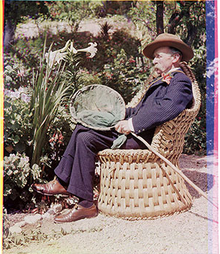
Color photography was possible long before
Kodachrome, as this 1903 portrait by
Sarah Angelina Acland
demonstrates, but in its earliest years the need for special equipment,
long exposures and complicated printing processes made it extremely
rare.
Color photography
was explored beginning in the 1840s. Early experiments in color
required extremely long exposures (hours or days for camera images) and
could not "fix" the photograph to prevent the color from quickly fading
when exposed to white light.
The first permanent color photograph was taken in 1861 using the three-color-separation principle first published by physicist
James Clerk Maxwell in 1855. Maxwell's idea was to take three separate black-and-white photographs through red, green and blue
filters. This provides the
photographer
with the three basic channels required to recreate a color image.
Transparent prints of the images could be projected through similar
color filters and superimposed on the projection screen, an
additive method of color reproduction. A color print on paper could be produced by superimposing
carbon prints of the three images made in their
complementary colors, a
subtractive method of color reproduction pioneered by
Louis Ducos du Hauron in the late 1860s.
Russian photographer
Sergei Mikhailovich Prokudin-Gorskii
made extensive use of this color separation technique, employing a
special camera which successively exposed the three color-filtered
images on different parts of an oblong
plate.
Because his exposures were not simultaneous, unsteady subjects
exhibited color "fringes" or, if rapidly moving through the scene,
appeared as brightly colored ghosts in the resulting projected or
printed images.
Implementation of color photography was hindered by the limited
sensitivity of early photographic materials, which were mostly sensitive
to blue, only slightly sensitive to green, and virtually insensitive to
red. The discovery of dye sensitization by photochemist
Hermann Vogel
in 1873 suddenly made it possible to add sensitivity to green, yellow
and even red. Improved color sensitizers and ongoing improvements in the
overall sensitivity of
emulsions steadily reduced the once-prohibitive long exposure times required for color, bringing it ever closer to commercial viability.
Autochrome, the first commercially successful color process, was introduced by the
Lumière brothers in 1907. Autochrome
plates incorporated a
mosaic color filter layer made of dyed grains of
potato starch,
which allowed the three color components to be recorded as adjacent
microscopic image fragments. After an Autochrome plate was
reversal processed to produce a positive
transparency,
the starch grains served to illuminate each fragment with the correct
color and the tiny colored points blended together in the eye,
synthesizing the color of the subject by the
additive method.
Autochrome plates were one of several varieties of additive color
screen plates and films marketed between the 1890s and the 1950s.
Kodachrome, the first modern "integral tripack" (or "monopack") color film, was introduced by
Kodak in 1935. It captured the three color components in a multi-layer
emulsion. One layer was sensitized to record the red-dominated part of the
spectrum, another layer recorded only the green part and a third recorded only the blue. Without special
film processing, the result would simply be three superimposed black-and-white images, but
complementary cyan, magenta, and yellow dye images were created in those layers by adding
color couplers during a complex processing procedure.
Agfa's similarly structured
Agfacolor Neu
was introduced in 1936. Unlike Kodachrome, the color couplers in
Agfacolor Neu were incorporated into the emulsion layers during
manufacture, which greatly simplified the processing. Currently
available color films still employ a multi-layer emulsion and the same
principles, most closely resembling Agfa's product.
Instant color film,
used in a special camera which yielded a unique finished color print
only a minute or two after the exposure, was introduced by
Polaroid in 1963.
Color photography may form images as positive transparencies, which can be used in a
slide projector,
or as color negatives intended for use in creating positive color
enlargements on specially coated paper. The latter is now the most
common form of film (non-digital) color photography owing to the
introduction of automated photo printing equipment. After a transition
period centered around 1995–2005, color film was relegated to a niche
market by inexpensive multi-megapixel digital cameras. Film continues to
be the preference of some photographers because of its distinctive
"look".
Digital photography
In 1981, Sony unveiled the first consumer camera to use a
charge-coupled device for imaging, eliminating the need for film: the
Sony Mavica.
While the Mavica saved images to disk, the images were displayed on
television, and the camera was not fully digital. In 1991, Kodak
unveiled the
DCS 100, the first commercially available digital single lens reflex camera. Although its high cost precluded uses other than
photojournalism and professional photography, commercial
digital photography was born.
Digital imaging uses an electronic
image sensor to record the image as a set of electronic data rather than as chemical changes on film.
[29] An important difference between digital and chemical photography is that chemical photography resists
photo manipulation because it involves
film and
photographic paper,
while digital imaging is a highly manipulative medium. This difference
allows for a degree of image post-processing that is comparatively
difficult in film-based photography and permits different communicative
potentials and applications.
Digital photography dominates the 21st century. More than 99% of
photographs taken around the world are through digital cameras,
increasingly through smartphones.
Synthesis photography
Synthesis photography is part of
computer-generated imagery
(CGI) where the shoot
http://nerobkhondoker.blogspot.com/ing process is modeled on real photography. The
CGI, creating digital copies of real universe, requires a visual
representation process of these universes. Synthesis photography is the
application of
analog and
digital photography
in digital space. With the characteristics of the real photography but
not being constrained by the physical limits of real world, synthesis
photography allows to get away from real photography.




